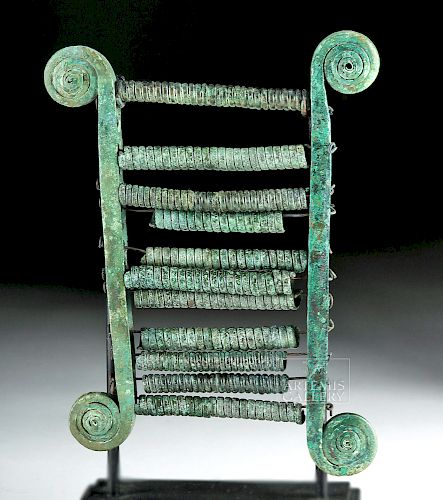Extremely Rare Phoenician Bronze Musical Chalcophone
Lot 92a
About Seller
Artemis Fine Arts
686 S Taylor Ave, Ste 106
Louisville, CO 80027
United States
Selling antiquities, ancient and ethnographic art online since 1993, Artemis Gallery specializes in Classical Antiquities (Egyptian, Greek, Roman, Near Eastern), Asian, Pre-Columbian, African / Tribal / Oceanographic art. Our extensive inventory includes pottery, stone, metal, wood, glass and textil...Read more
Categories
Estimate:
$10,000 - $15,000
Absentee vs Live bid
Two ways to bid:
- Leave a max absentee bid and the platform will bid on your behalf up to your maximum bid during the live auction.
- Bid live during the auction and your bids will be submitted real-time to the auctioneer.
Bid Increments
| Price | Bid Increment |
|---|---|
| $0 | $25 |
| $300 | $50 |
| $1,000 | $100 |
| $2,000 | $250 |
| $5,000 | $500 |
| $10,000 | $1,000 |
| $20,000 | $2,500 |
| $50,000 | $5,000 |
| $100,000 | $10,000 |
| $200,000 | $20,000 |
About Auction
By Artemis Fine Arts
May 10, 2018
Set Reminder
2018-05-10 10:00:00
2018-05-10 10:00:00
America/New_York
Bidsquare
Bidsquare : Fine Ethnographic / Asian / Ancient Art
https://www.bidsquare.com/auctions/artemis-gallery/fine-ethnographic-asian-ancient-art-3213
Featuring antiquities from around the world including Pre-Columbian, Tribal, Classical, Asian, so much more! Artemis Fine Arts info@artemisfinearts.com
Featuring antiquities from around the world including Pre-Columbian, Tribal, Classical, Asian, so much more! Artemis Fine Arts info@artemisfinearts.com
- Lot Description
Ancient Eastern Mediterranean, Phoenicia, ca. 8th to 7th century BCE. A beautiful example of a bronze musical instrument called a chalcophone, composed of two parallel bars - each with its terminals twisted into tight spirals - linked by eleven bronze wires with thick springs on them. To be played, someone would shake or pluck at the springs. The instrument has a delightful, whimsical appearance. An ivory pyxis from Phoenicia held by the British Museum (N.973) depicts a frieze of musicians playing double pipes, the tambourine, and chalcophones amidst palm and lotus trees, while a goddess overseeing a banquet observes, giving us an idea of how it would have been played and under what circumstances. Size: 5.1" W x 6.9" H (13 cm x 17.5 cm); 8.1" H (20.6 cm) on included custom stand.
Fascinatingly, chalcophones are found almost exclusively in Phoenicia and in South Italian Iron Age burials, suggesting a link between east and west. Similar, but not identical instruments also have been found in Ur. Chalcophones are often found alongside a type of instrument called "sonagliera," similar to chimes. In the South Italic contexts, they are associated with the graves of adult women. This is also true in Assyrian contexts, and the later Apulian sistrum - a similar instrument, depicted on red-figure vases is also associated with women, and, specifically, with religious contexts. So who would have used this beautiful instrument? It seems likely that it would have belonged to a high status woman, perhaps a priestess, musician, or dancer at religious ceremonies.
See a similar example at Bonhams London, which sold in 2014 for US $20,598: https://www.bonhams.com/auctions/21926/lot/94/
Provenance: private Davis collection, Houston, Texas, USA
All items legal to buy/sell under U.S. Statute covering cultural patrimony Code 2600, CHAPTER 14, and are guaranteed to be as described or your money back.
A Certificate of Authenticity will accompany all winning bids.
We ship worldwide and handle all shipping in-house for your convenience.
#133024One of the springs is bent, and one other is missing one end of its support rod. Beautiful bright green patina.Condition
- Shipping Info
-
All shipping is handled in-house for your convenience. Your invoice from Artemis Gallery will include shipping calculation instructions. If in doubt, please inquire BEFORE bidding for estimated shipping costs for individual items.
-
- Buyer's Premium



 EUR
EUR CAD
CAD AUD
AUD GBP
GBP MXN
MXN HKD
HKD CNY
CNY MYR
MYR SEK
SEK SGD
SGD CHF
CHF THB
THB















